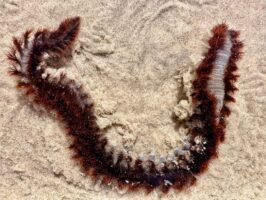Beaches are often a place of relaxation, but recently, an unusual and painful threat has emerged: Bearded Fireworms, also known as bristle worms. These marine creatures, a type of polychaete worm, have been spotted washing ashore on large logs. While they may look fascinating, a sting from one of these worms can leave you in severe pain, with a burning sensation that lasts up to three hours and a scar that could linger for weeks.
Understanding the Threat: What Are Bearded Fireworms?
Bearded Fireworms, known scientifically as polychaetes, are segmented marine worms that have earned their name from the bristles covering their bodies. According to Jace Tunnell, Director of Community Engagement at the Harte Research Institute, these bristles are not just for show—they can be extremely painful if they come into contact with your skin.
“These are polychaetes, what we call them in the science world,” Tunnell explains. “Bristle worms is another name for them, and they get that name because of the bristles all over their body. If you touch them, the bristles can come off on your skin, and it feels like fire.”
Though encounters with Bearded Fireworms are relatively rare, Tunnell advises beachgoers to stay alert. These worms can pose a significant danger, especially to those who might accidentally come into contact with them.
The Painful Reality: What Happens If You Get Stung?
The sting of a Bearded Fireworm is not something to take lightly. Tunnell describes the sensation as feeling like “fire stinging you for about three hours.” In addition to the intense pain, a sting can also cause dizziness and nausea. However, despite the severity of the pain, there have been no reports of fatalities from Fireworm stings.
Bearded Fireworms are typically found inside logs that wash ashore. They prefer damp, dark environments and often feed on gooseneck barnacles, which can also be found on these logs. Tunnell points out that these worms are usually hidden inside openings in the logs, staying wet and protected from the sun.
What to Do If You Get Stung
If you happen to get stung by a Bearded Fireworm, there are a few steps you can take to alleviate the pain. Tunnell recommends using tape to remove the bristles from your skin, followed by applying vinegar or isopropyl alcohol to the affected area. While these remedies may help reduce the pain, the sting is still likely to be quite painful.
The Fireworms defensively react when touched, even if it’s just with a stick. “If you touch it, those bristles will shoot out, and the whole thing will turn white,” Tunnell explains.
Admire from Afar: A Safe Way to Appreciate Fireworms
Despite their painful sting, Bearded Fireworms are fascinating creatures. Tunnell suggests that there is nothing wrong with admiring them—make sure to do so from a safe distance. “I always ask people to take a glass or a jar with them and put whatever they find inside. These worms look amazing once you put them in water. They have gills all over their back, and the bristles really glisten.”
So, next time you’re at the beach and see a log washed ashore, take a moment to appreciate the unique beauty of Bearded Fireworms—but keep your distance to avoid their painful sting.

